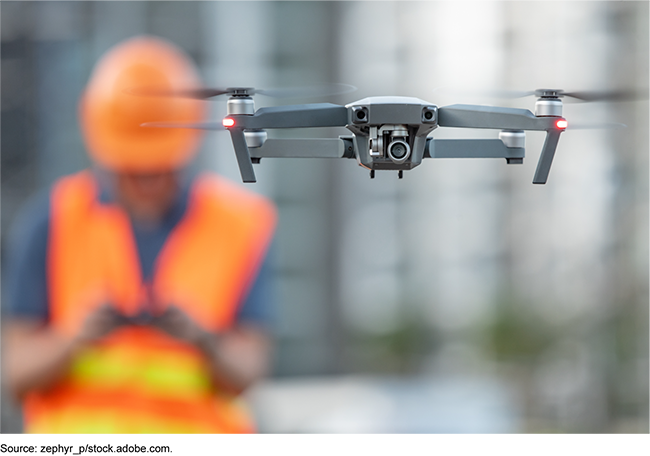Aviation Safety: Federal Efforts to Address Unauthorized Drone Flights Near Airports
Fast Facts
The Federal Aviation Administration prohibits unauthorized drone flights near airports because they can pose safety risks to other aircraft and disrupt air traffic control.
Local authorities respond to these incidents with assistance from the federal government, if needed. Some federal agencies have authority to use drone detection and counter-drone technologies, in certain situations. The military has used these technologies for many years and FAA is planning for their use in the airport environment.
We recommended that Congress consider changing laws on the use of these technologies at airports.

Highlights
What GAO Found
Tactical and airport response plans and a federal interagency agreement describe the roles for responding to errant or malicious drone operations near airports. As described in these plans, local law enforcement authorities are expected to be the first to respond to a drone sighting. The federal government can assist in responding to an incident at an airport as outlined in the federal interagency agreement.
The Departments of Homeland Security (DHS), Justice (DOJ), Defense, and Energy have express statutory authority to use counter-drone technologies if certain statutory criteria are met. They also have federal statutory exemptions from specified federal criminal laws that are potentially applicable to the use of such technologies. These technologies can be used at an airport by DHS and DOJ if the drone poses, for example, a credible threat to safety or security and the DHS Secretary or the Attorney General designates the airport for an emergency response. GAO concluded that modifications to statutory authorities for drone detection and counter-drone operations could better protect airports against an active drone threat.
The Federal Aviation Administration (FAA) is testing drone detection and counter-drone technologies and is required to develop a plan for their use at airports. FAA is also pursuing several efforts to allow increased and routine drone operations. In various documents, FAA acknowledges the effects counter-drone technologies may have on other integration efforts but does not address how it will assess those effects. Including steps for this assessment in the agency's forthcoming drone integration strategy could help ensure that such technologies will work in harmony with FAA's other efforts, such as developing a drone traffic management system and rules for operating drones beyond operators' visual line of sight.
Unauthorized Drone Flights Near Airports Present Safety and Security Threats

This is a public version of a sensitive report that was issued in October 2023 and omits some information that DHS deemed sensitive. In some cases, the omitted information was, in part, the basis for GAO conclusions presented in this report.
Why GAO Did This Study
In recent years, FAA has reported a significant number of drone sightings at or near airports. FAA prohibits drone operations that interfere with airport operations. Whether errant or malicious, unauthorized drone flights around airports present safety and security threats and can result in flight delays.
GAO was asked to review drone detection and mitigation issues at airports. This report examines (1) federal and local roles for responding to a drone incident at an airport, (2) federal legal authorities related to using drone detection and counter-drone technology at airports, and (3) FAA actions to plan for using the technology at airports and its effects on drone integration efforts.
GAO reviewed relevant federal statutes, regulations, agency documents, and reports. GAO interviewed FAA and DHS, and 18 aviation, law enforcement, and other entities to obtain a range of perspectives. GAO also reviewed FAA planning documents to determine how counter-drone technologies were incorporated into FAA's drone integration efforts.
Recommendations
GAO recommends that Congress, as appropriate, amend pertinent statutory authorities related to drone detection and counter-drone operations at airports. GAO also recommends that FAA ensure its drone integration strategy reflects how it will assess the effects of counter-drone technologies. The Department of Transportation agreed with this recommendation.
Matter for Congressional Consideration
| Matter | Status | Comments |
|---|---|---|
| To help ensure the safety and security of the national airspace system, Congress should act to amend pertinent statutory authorities that exist for federal and non-federal entities, as it deems appropriate, with respect to drone detection and counter-drone operations at airports. (Matter for Congressional Consideration 1) | When we confirm what actions the agency has taken in response to this recommendation, we will provide updated information. |
Recommendations for Executive Action
| Agency Affected | Recommendation | Status |
|---|---|---|
| Federal Aviation Administration | As part of ongoing efforts to develop an overarching strategy for drone integration, the Administrator of FAA should ensure that the strategy reflects plans for assessing how drone detection and mitigation technology will affect technologies aimed at allowing increased and routine drone traffic, particularly at airports. (Recommendation 1) |
When we confirm what actions the agency has taken in response to this recommendation, we will provide updated information.
|
